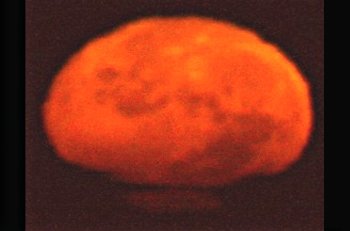 Where's Saturn? Is that a UFO--or the ISS? What's the name of that star? Get the answers from mySKY--a fun new astronomy helper from Meade. Where's Saturn? Is that a UFO--or the ISS? What's the name of that star? Get the answers from mySKY--a fun new astronomy helper from Meade. MARS ALERT: An hour or so after the sun goes down tonight, step outside and look east. Weather permitting, you'll see red Mars rising in company with the nearly full Moon. It's a beautifully close pairing of two of the brightest objects in the heavens: sky map. Once you've located Mars, try looking at it through a backyard telescope. Dan Petersen of Racine, Wisconsin, took this picture through his 10-inch 'scope the night after Thanksgiving: 
Earth and Mars are converging for a close encounter in December. "As Earth races towards Mars, the telescopic views are becoming increasingly spectacular," says Petersen. Conspicuous in Petersen's photo is the blue "North Polar Hood"—a giant icy cloud that forms over the Martian north pole during winter. Why blue? That's the color of sunlight scattered from tiny crystals of H2O and CO2 ice floating in the cloud. Less than a week before this photo was taken, Peterson took another that captured a bright blue gleam—"possibly sunlight scattered from a towering vertical cloud structure within the hood," he speculates. Whatever the explanation, it shows that Mars is now worth watching. more images: from Peter Garbett of Sharnbrook, England; from Guenther Strauch of Borken, NRW, Germany; from Friedrich Deters of LaGrange, North Carolina. MOON MIRAGE: This weekend, Mila Zinkova saw something disturbing on the western horizon of San Francisco Bay--a fiery mushroom cloud! On closer inspection, it was only the Moon: 
"This is a mock mirage of the setting Moon," she explains. A temperature inversion created a dim, inverted image of the Moon, which rose up to meet the real Moon as it set. Together, the two moons combined to make a "mushroom cloud." Sometimes mock mirages like this one end with a beautiful green flash, but on this evening "the horizon was not clear enough to see the green," she says. A note to California photographers: Cool offshore currents combined with warm Santa Ana winds are creating conditions favorable for mirages. This is a good week to go to the beach and watch the Sun and Moon set.
Comet 17P/Holmes Photo Gallery
[Interactive World Map of Comet Photos]
[sky map] [ephemeris] [3D orbit] [Night Sky Cameras] | 
